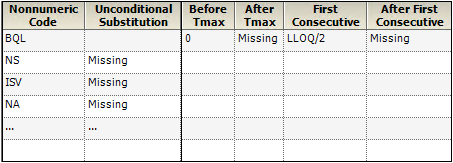-
A rule in a rule set can only do a conditional substitution or an unconditional substitution, not both.
-
If a rule set has rules for the same exact non-numeric value, then the last rule is applied.
-
A rule set can list several non-numeric codes with different substitution rules. These rules are considered independent of each other. For example, if the rule set states to substitute concentrations equal to < LLOQ and set them to BQL, and then another rule within the same rule set indicates to take all BQL values and set them to zero, concentrations of < LLOQ are shown as BQL and not zero, regardless of the order of the rules.
-
The BQL object provides the option to map a column with the LLOQ values or to enter a static LLOQ value within the rule set. If both options are used the static option takes precedence over the mapped LLOQ column.
-
A numeric value is allowed to be entered as a non-numeric code. The tool will search for the exact value with the exact precision before a substitution takes place. The search will take place in the column mapped to Concentration unless the Status Code option is selected. In that case the search will take place in the column mapped to the Status Code instead.
-
A rule that resides within the folder BQL Rules can be used in a BQL object or several BQL objects. An internal rule resides within a given BQL object and cannot be used by another object. If the rules are the same there is no difference in the results if an external or internal rule is used.
-
Substitutions are either unconditional or conditional.
-
The nonnumeric code column must contain non-numeric values.
-
Only one column can apply rules for the below LLOQ concentration.
Some common substitution rules for BQL samples are presented in the table below.

The substitution rules are typically defined in standard operating procedures or method sheets for a given company or department. The rules can become more complex when a user wishes to make a distinction between concentrations that are below the quantification limit (BQL) and below the detection limit (BDL). In general, a substitution rule is defined by the list of possible non-numeric representations for concentration and the values to be substituted for each. One possible substitution rule for PK analyses is presented below:

The BQL object transforms observation values from non-numeric status codes to number values for use in analyses and plots. It can also convert unusable concentration values to non-numeric status codes. The BQL object creates a new worksheet based on an existing one, by copying over selected columns.
It transforms values in the input worksheet as specified by user-defined rules. Numeric concentration data and the non-numeric concentration status codes can be in the same or different columns in the dataset.
The BQL object also stores information about the lower limit of quantification (LLOQ) for one or more sampling assays. Users can specify an LLOQ and the new column header into which it is placed, or identify an existing column containing the LLOQ for each observed concentration. The LLOQ, if any, can be used to define how status codes are transformed.
The BQL object generates one worksheet and one text file.
Output: The worksheet with the updated concentration column.
Settings: The input worksheet used and the options selected.
